Contact Jr.
Pacific Amusements 1933
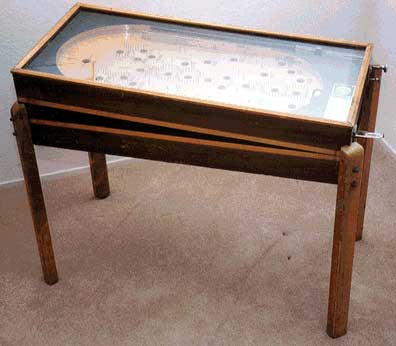
History:
This game, designed by Harry Williams, was the first pinball to move the ball with electricity. This prewar game requires the player to nudge and gently shove the cabinet to manipulate the balls into the desired holes. There are no flippers. The game has only two solenoids and one contact point. This lends action to the game and requires the player to plan his shots in order to make much higher scores.
Contact claims many firsts, the first time a mechanism or feature was ever used in a pinball machine.
Richard Beuschell, in "Pinball 1" says the following:
"The game of Contact has a staggering array of firsts to its credit, not one of which are really true. But that in no way detracts from the achievement or significance of the game."
Contact is the first pinball game with electricity and the first to run off batteries.
Contact is also the first game to have a bell and therefore the first with sound. It is the first that actually moved the ball with added momentum. It was the first game made by the soon to be greatest pinball designer of all time, Harry E. Williams. Mr. Beuschell finishes the list of firsts with the first pinball game to be made in Southern California and the first by a company called Pacific Amusement.
Harry William also invented the tilt mechanism. Later versions of Contact included a tilt mechanism. My game has the tilt in the center, front of the game but I have also seen it on the left side, closer to the playfield area.
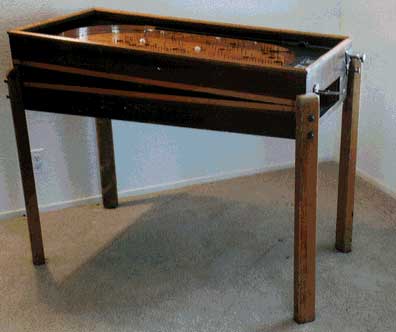
- Baby 40 by 76 centimeters counter top version
- Master 45 by 91 centimeters
- Junior 61 by 112 centimeters almost identical to the size today
- Senior 76 by 152 centimeters
Between 20,000 and 25,000 games were produced and it sold for $75 (equivalence?).
Harry was issued patent 2,073,132 in March of 1933.
Play:
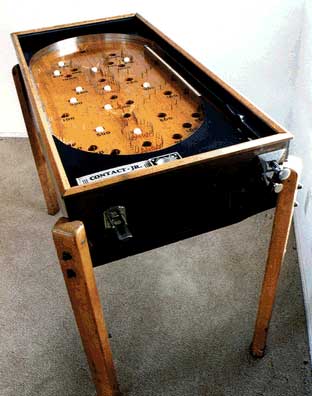
My game is a Junior. It is the same size as a standard pinball machine. The cabinet is short and is a wood finish with a nice accent of a darker wood down the center.
There is an instruction card on the lower right of the cabinet and contains a short description of play. It is black lettering on shinny silver paper.
Contact Jr. Patent Pending * 800 and 3000 pockets are progressive scoring pockets. * After balls are played into 800 or 3000 pockets, shoot for CONTACT pocket which automatically progresses ball to higher denomination pocket below. * CONTACT BALL always returns for free play. * ODD BALL counts double in pocket played. Pacific Amusement (stuff missing...) 320 So. Hope St. (more missing...)
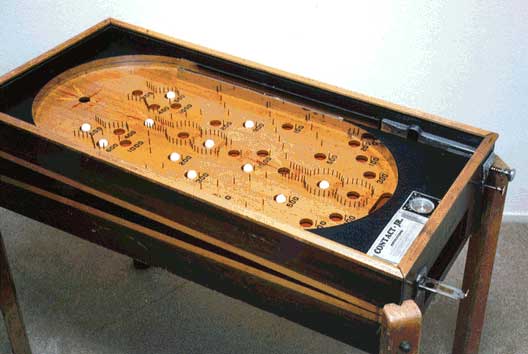
The playfield is arched at the top and bottom and is covered with 32 holes and lots of nails (pins). There are various areas of interest down both sides, similar to other games of the same era. Scoring is by adding the point value of a particular hole. On the sides these scores vary between 100 and 1,000.
There is a spring at the left bottom of the top arch that sends the ball back over the top of the arch if the ball has sufficient momentum to reach the spring.
Down the center are two protected areas, protected by fences of nails, and containing high point values, 1,500 to 5,000. There is an electric hole at each of the entrances to the two fenced areas. At the top of the game is the contact hole. Each of the electric holes has a solenoid under it, prepared to kick the ball out and farther down the field.
The object is to load both the electric holes at the entrance to the high point areas with a ball and then put a ball into the contact hole. This causes contact to be made and the two solenoids under the electric holes energize, pushing the balls into the high paying areas. Then the player attempts to repeat this, adding more balls into the fenced area.
Balls entering the contact hole are returned for play. Both electric holes do not need to be loaded but it helps get a higher score.
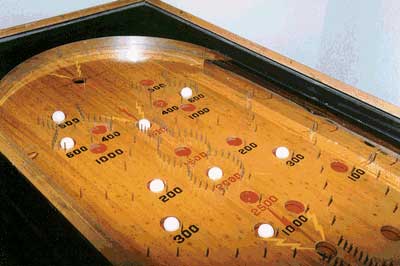
So, you played all the balls, did your best, and now want to know your score? Did you bring your calculator? Oh, calculators were not invented yet! So, you need to total your score yourself, by adding eleven large numbers together, in your head, unless you happend to bring along a pencil and paper when you decided to go out and play. And you need to be able to double one of the numbers.
Having played games that earlier games that are scored only by balls falling into holes, this game definitely is more exciting. First you have to get a ball in the electric hole. This is no easy task and is exciting in the normal sense. But it is the anticipation of getting a ball there and then desparately trying to get a following ball into the contact hole, when the adrenelan really starts to flow. The subsequent ring of the bell and satisfaction of knowing you have drastically raised your score is what makes this game such fun.
No, there are no flippers. This game is about precision and careful nudging.
Construction:
The game is built out of natural finish wood, with a darker wood in the sides of the cabinet for accent. The slash of dark wood is bordered with very light wood.
There is a varnish like finish on the playfield with only the words contact and the jagged lightning bolt patterns around the electric holes and the contact hole.
I do not know what the legs looked like. Mine has bingo style legs.
There are some simple metal castings in the game. The ball lift mechanism is a simple rotating lift. The ball shooter and lift plunger are in a simple art deco style, with a double triangle theme. And there is a nice casting where the ball lift shoves the ball out into the shooting lane.
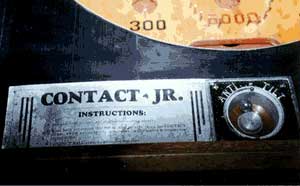
The tilt mechanism is purely mechanical and only provides the proprietor notification of the game having been shook aggressively. This is a ball on a pedestal. The coin slide mechanism allows the pedestal to retract, the ball rolls to the lowest point, that being on the pedestal, and then when the coin slide is retracted, the pedestal raises with the ball on top.
Should the machine shake too much, the ball will fall. The only way to get the ball back up is to insert addtional coins, so it is easy for the proprietor to see if the player has cheated.
The coin slide takes nickles. It pushes a board under the playfield foward to allow the balls to fall through holes and into a return trough. It resets the tilt. A ball lift mechanism raises the balls one at a time to the shooter and they are plunged by the player at will. The game is powered by a six volt lantern battery and does not use any current unless being played.
There are three levels of boards inside the game. At the top is the playfield. The playfield has holes to catch the balls and retain them in the score holes. The second board is painted red and is mounted on a slide. The coin slide moves this board, exposing the matching holes to those in the playfield, and allowing the balls to drop through to the return feed. Finally, at the bottom, is a board that guides the balls back to the ball lift and also has the solenoids mounted. None of the wood work is impressive! In fact it all looks like a home wood working project. There is minimal reinforcing and no fancy joinery.
Opening the game for servicing is like a puzzle. It reminds me of the magic boxes I saw as a child. There is a hidden slot that conceals a trip latch, which allows an unexpected part of the box to open. In Contact there is a latch hidden inside the coin door on the left side of the game. It is the old cabinet style where a bolt is extended and then rotated into a slot to hold it in position. You rotate and pull the bolt in. Then what? The back of the game, including all three levels of the playfield, pulls out! The playfield is not screwed to the cabinet and the back pannel is not glued or attached to the rest of the game. The whole thing pulls out, leaving the glass still in the guides. The cabinet is empty and the glass can be removed now out the back of the game.
The playfield on my game has a unique characteristic in the appearance of the finish on the playfield. It appears as if there are two centimeter diameter spider webs on roughly ten centimeter centers scattered all over the board. I do not know if this was an intentional effect or caused by age. My guess is the varnish was holed or cracked in various areas. The process of cleaning and waxing the play surface caused the wax to slowly enter these cracks and spread under the playfield. The effect is barely noticable as the wax is roughtly the color of the natural wood.

The wiring diagram is trivial. The single bell and two solensoids are wired in series and are triggered by a mercury switch mounted on a lever under the contact hole. A ball entering the contact hole will cause the lever to tilt, a mercury vial attached will tilt as well, and the mercury inside will complete the electrical circuit. The wire is fabric coated copper and joins are wrapped in friction tape. There are burn marks on the under side of the playfield where the soldering iron not only melted the solder at the wiring connections but also burned the wood.
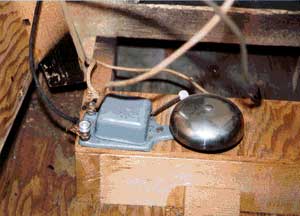
The bell appears to be a ordinary door bell and uses a clapper driven by twin soleniods and the expected contact interuppter. I cannot tell if this bell is original.
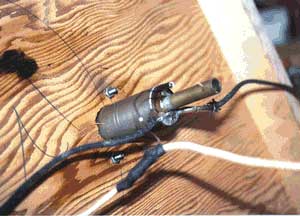
The solenoids are crude by today's standards, being a coil of wire around a brass tube encased in a steel cylinder. The solenoid itself is a metal rod with a seven centimeter metal finger attached. It is the metal finger that ejects the ball from the hole as the solenoid is pulled up into the solenoid coil.
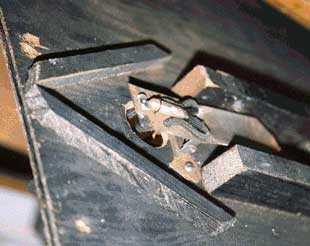
Under the contact hole is a seesaw lever with a glass ampule attached. The ampule contains mercury and two contacts. The ball entering the contact hole lands on the far side of the seesaw, causing the ampule to raise, making the mercury to flow down to the wires, and completing the circuit. The ball rolls off the seesaw thus allowing the seesaw to return to the original and ready position.
The serial number is B225 and is stamped into the wood above the coin door. There is a number 129 on the bottom of the playfield, written in pencil. There are also some initials written on the bottom of the playfield, perhaps HEW.
Sources:
Richard Bueschell in Pinball 1, 1988
Heribert Eiden and Jurgen Lukas in Pinball Machines, 1992
Russ Jensen in Contact: Pinball Goes Electric! in GameRoom, September 1994
Bobbye Claire Natkin and Steve Kirk in All About Pinball, 1977
Edward Trapunski in Special When Lit, 1979
